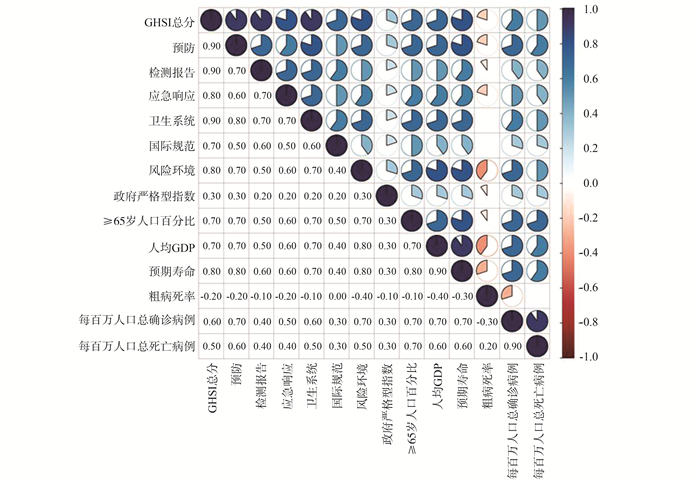-
摘要:
目的 研究全球卫生安全指数(Global Health Security Index,GHSI)与COVID-19疫情的关系,探索GHSI的价值。 方法 对来自公开数据库的159个国家(地区)进行横断面研究。用Spearman分析GHSI与COVID-19大流行的相关性,并绘制相关性矩阵。拟合多元线性回归模型控制各国社会经济及健康状况等因素,进一步研究GHSI与COVID-19大流行相关指标的关联。 结果 159个国家(地区)2021年GHSI总分平均(41.19±13.41)分,最小值16.10分(也门),最大值75.90分(美国)。截至2021年12月31日159个国家(地区)COVID-19粗病死率0.02(0.01,0.03),最小值< 0.01(不丹),最大值0.20(也门)。每百万人口总确诊病例数50 844.42(5 807.88,101 572.70)例,最小值22.26(瓦努阿图共和国),最大值251 608.38(斯洛伐克)。每百万人口总死亡病例数590.71(105.66,1 533.20),最小值3.10(布隆迪),最大值6 075.95(秘鲁)。多元线性回归分析显示,GHSI检测报告评分与每百万人口总确诊病例呈负相关(β=-0.34,P=0.038),与每百万人口总死亡病例呈负相关(β=-0.42,P=0.025);GHSI国际规范评分与每百万人口总确诊病例呈负相关(β=-0.49,P=0.041),GHSI卫生系统评分与每百万人口总死亡病例呈正相关(β=0.65,P=0.003),GHSI风险环境评分与粗病死率呈负相关(β=-0.91,P=0.044)。 结论 GHSI在评估各国家(地区)应对COVID-19大流行的能力方面缺乏有效性,但仍存在一定价值。 Abstract:Objective To investigate the correlation between Global Health Security Index (GHSI) and the epidemic situation of COVID-19 and to explore the value of GHSI. Methods A cross-sectional study of 159 countries from an open database was conducted. Analyze the correlation of GHSI with the COVID-19 pandemic with Spearman and plot the correlation matrix. Fitted multiple linear regression models controlled for variables such as socioeconomic and health conditions in countries, and further studied the association of GHSI with COVID-19 pandemic outcome indicators. Results The mean total GHSI score of the 159 countries in 2021 was (41.19±13.41), with a minimum of 16.10 (Yemen) and a maximum of 75.90 (The United States). As of 31 December 2021, the crude case fatality rate of COVID-19 in 159 countries was 0.02 (0.01, 0.03), with a minimum < 0.01 (Bhutan) and a maximum of 0.20 (Yemen). The total number of confirmed cases per million population was 50 844.42 (5 807.88, 101 572.70), with a minimum of 22.26 (Republic of Vanuatu) and a maximum of 251 608.38 (Slovakia). The total number of deaths per million population was 590.71 (105.66, 1 533.20), with a minimum of 3.10 (Burundi) and a maximum of 6 075.95 (Peru). Multiple linear regression analysis results showed that the Detect score of GHSI was negatively correlated with the total confirmed cases per million population (β=-0.34, P=0.038) and the total deaths per million population (β=-0.42, P0.025); the Norms score of GHSI was negatively correlated with the total confirmed cases per million population (β=-0.49, P0.041), and the Health score of GHSI was positively correlated with the total deaths per million population (β=0.65, P0.003). Risk score of GHSI was inversely correlated with case fatality rate(β=-0.91, P0.044). Conclusion The GHS Index has limited value in assessing a country's capacity to respond to the COVID-19 pandemic. Nevertheless, it has potential value in others. -
表 1 GHSI及6个维度释义
Table 1. Interpretation of GHSI and six categories
维度 编码 英文 释义 GHSI总分 GHSI GHSI 全球卫生安全指数 预防 GHSI1 Prevent 预防病菌的出现或泄露 检测报告 GHSI2 Detect 快速查明并报告有可能引发全球关注
的传染病应急响应 GHSI3 Respond 快速响应并减缓传染病的扩散 卫生系统 GHSI4 Health 建立稳健的卫生系统,能够收治患者,
有充足的医护人员国际规范 GHSI5 Norms 遵守全球相关规范,承诺提高国家能力,
在卫生安全方面提供资金用于补短板风险环境 GHSI6 Risk 国家抵抗生物脆弱性威胁的能力 表 2 159个国家(地区)GHSI、社会经济及健康水平(分)
Table 2. GHSI scores, socioeconomic and health levels in 159 countries (score)
变量(N=159) Min P25 M P75 Max x sx值 GHSI总分 16.10 30.35 38.30 51.70 75.90 41.19 13.41 GHSI1预防 0.80 16.05 29.70 44.05 79.40 31.15 17.41 GHSI2检测报告 4.20 22.20 33.30 47.65 91.50 36.11 18.75 GHSI3应急响应 17.50 29.40 36.50 46.25 70.70 38.98 12.18 GHSI4卫生系统 7.70 18.35 31.00 50.60 75.20 34.48 18.40 GHSI5国际规范 21.90 40.60 47.70 59.70 81.90 50.08 12.76 GHSI6风险环境 24.90 44.95 55.00 66.25 89.00 56.36 14.98 政府严格性指数 6.48 35.19 46.30 55.33 90.74 45.66 16.75 65岁及以上人口百分比(%) 1.14 3.54 6.22 14.37 27.05 8.83 6.35 人均GDP(美元) 661.20 4 347.10 12 236.70 27 827.40 116 935.60 19 207.53 20 130.69 预期寿命(年) 53.28 67.12 74.25 78.23 84.63 72.74 7.54 表 3 159个国家(地区)COVID-19大流行情况
Table 3. The epidemic situation of COVID-19 in 159 countries
变量(N=159) Min P25 M P75 Max x sx值 粗病死率(%) < 0.01 0.01 0.02 0.03 0.20 0.02 0.02 每百万人口总确诊病例数(例) 22.26 5 807.88 50 844.42 101 572.70 251 608.38 64 027.52 64 383.40 每百万人口总死亡病例数(例) 3.10 105.66 590.71 1 533.20 6 075.95 989.01 1 095.92 表 4 COVID-19每百万人口总确诊例数标化数据多元线性回归分析
Table 4. Multiple linear regression of standardized data per million confirmed cases of COVID-19
变量(N=159) β值 sx值 t值 (95% CI)值 P值 GHSI1预防 0.30 0.19 1.584 -0.08~0.68 0.115 GHSI2检测报告 -0.34 0.16 -2.092 -0.66~-0.02 0.038 GHSI3应急响应 0.18 0.22 0.803 -0.26~0.62 0.423 GHSI4卫生系统 0.23 0.19 1.201 -0.15~0.60 0.232 GHSI5国际规范 -0.49 0.24 -2.061 -0.95~-0.02 0.041 GHSI6风险环境 0.52 0.33 1.564 -0.14~1.17 0.120 政府严格性指数 0.03 0.13 0.210 -0.22~0.28 0.834 65岁及以上人口百分比(%) 0.48 0.13 3.727 0.22~0.73 < 0.001 人均GDP(美元) 0.07 0.09 0.800 -0.11~0.25 0.425 预期寿命(年) -0.06 0.78 -0.075 -1.60~1.49 0.941 RSE 0.504 adj R2值 0.493 F值 16.370 P值 < 0.001 注:COVID-19相关数据截至2021年12月31日; RSE表示残留标准误差; adj R2表示调整后R2值。 表 5 COVID-19每百万人口总死亡例数标化数据多元线性回归分析
Table 5. Multiple linear regression of standardized data per million deaths from COVID-19
变量(N=159) β值 sx值 t值 (95% CI)值 P值 GHSI1预防 0.30 0.22 1.379 -0.13~0.74 0.170 GHSI2检测报告 -0.42 0.19 -2.257 -0.78~-0.05 0.025 GHSI3应急响应 0.29 0.26 1.129 -0.22~0.79 0.261 GHSI4卫生系统 0.65 0.22 2.979 0.22~1.08 0.003 GHSI5国际规范 -0.35 0.27 -1.296 -0.88~0.18 0.197 GHSI6风险环境 -0.45 0.38 -1.184 -1.20~0.30 0.238 政府严格性指数 0.15 0.14 1.006 -0.14~0.43 0.316 65岁及以上人口百分比(%) 0.52 0.15 3.523 0.23~0.80 0.001 人均GDP(美元) -0.22 0.10 -2.175 -0.43~-0.02 0.031 预期寿命(年) 0.59 0.90 0.660 -1.18~2.36 0.510 RSE 0.578 adj R2值 0.392 F值 11.190 P值 < 0.001 注:COVID-19相关数据截至2021年12月31日; RSE表示残留标准误差; adj R2表示调整后R2值。 表 6 COVID-19粗病死率标化数据多元线性回归分析
Table 6. Multiple linear regression of standardized data case fatality rate from COVID-19
变量(N=159) β值 sx值 t值 (95% CI)值 P值 GHSI1预防 -0.32 0.26 -1.214 -0.83~0.20 0.227 GHSI2检测报告 -0.36 0.22 -1.647 -0.80~0.07 0.102 GHSI3应急响应 0.03 0.30 0.096 -0.57~0.63 0.924 GHSI4卫生系统 0.46 0.26 1.786 -0.05~0.97 0.076 GHSI5国际规范 0.59 0.32 1.854 -0.04~1.23 0.066 GHSI6风险环境 -0.91 0.45 -2.033 -1.80~-0.03 0.044 政府严格性指数 -0.23 0.17 -1.322 -0.56~0.11 0.188 65岁及以上人口百分比(%) -0.10 0.17 -0.579 -0.44~0.24 0.564 人均GDP(美元) -0.21 0.12 -1.734 -0.45~0.03 0.085 预期寿命(年) 2.28 1.06 2.146 0.18~4.38 0.034 RSE 0.685 adj R2值 0.116 F值 3.082 P值 0.001 注:COVID-19相关数据截至2021年12月31日; RSE表示残留标准误差; adj R2表示调整后R2值。 -
[1] WHO. The COVID-19 weekly operational update reports[EB/OL]. (2022-03-29)[2022-03-31]. https://www.who.int/emergencies/diseases/novel-coronavirus-2019/situation-reports. [2] Our world in data. COVID-19 data explorer[EB/OL]. (2022-02-11)[2022-02-11]. https://ourworldindata.org/covid-cases. [3] Cheng C, Barceló J, Hartnett AS, et al. COVID-19 government response event dataset (CoronaNet v. 1.0)[J]. Nat Hum Behav, 2020, 4(7): 756-768. DOI: 10.1038/s41562-020-0909-7. [4] Hale T, Angrist N, Goldszmidt R, et al. A global panel database of pandemic policies (Oxford COVID-19 Government Response Tracker)[J]. Nat Hum Behav, 2021, 5(4): 529-538. DOI: 10.1038/s41562-021-01079-8. [5] Perra N. Non-pharmaceutical interventions during the COVID-19 pandemic: a review[J]. Phys Rep, 2021, 913: 1-52. DOI: 10.1016/j.physrep.2021.02.001. [6] Teslya A, Pham TM, Godijk NG, et al. Impact of self-imposed prevention measures and short-term government-imposed social distancing on mitigating and delaying a COVID-19 epidemic: a modelling study[J]. Plos Med, 2020, 17(7): 1003166. DOI: 10.1371/journal.pmed.1003166. [7] Hsiang S, Allen D, Annan-Phan S, et al. The effect of large-scale anti-contagion policies on the COVID-19 pandemic[J]. Nature, 2020, 584(7820): 262-267. DOI: 10.1038/s41586-020-2404-8. [8] Ravi SJ, Warmbrod KL, Mullen L, et al. The value proposition of the Global Health Security Index[J]. BMJ Glob Health, 2020, 5(10): 003648. DOI: 10.1136/bmjgh-2020-003648. [9] Kelley J G, Simmons B A. Introduction: The power of global performance indicators[J]. Int Organ, 2019, 73(3): 491-510. DOI: 10.1017/S0020818319000146. [10] NTI, Johns Hopkins, Economist Impact. 2021 Global Health Security Index[EB/OL]. (2021-12-08)[2022-02-11]. https://www.ghsindex.org/. [11] Khalifa BA, Abbey EJ, Ayeh SK, et al. The Global Health Security Index is not predictive of vaccine rollout responses among OECD countries[J]. Int J Infect Dis, 2021, 113: 7-11. DOI: 10.1016/j.ijid.2021.09.034. [12] Abbey EJ, Khalifa BAA, Oduwole MO, et al. The Global Health Security Index is not predictive of coronavirus pandemic responses among organization for economic cooperation and development countries[J]. Plos One, 2020, 15(10): e0239398. DOI: 10.1371/journal.pone.0239398. [13] Haider N, Yavlinsky A, Chang YM, et al. The Global Health Security index and Joint External Evaluation score for health preparedness are not correlated with countries' COVID-19 detection response time and mortality outcome[J]. Epidemiol Infect, 2020, 148: e210. DOI: 10.1017/S0950268820002046. [14] Kaiser M, Chen AT, Gluckman P. Should policy makers trust composite indices? A commentary on the pitfalls of inappropriate indices for policy formation[J]. Health Res Policy Syst, 2021, 19(1): 40. DOI: 10.1186/s12961-021-00702-4. [15] Chang CL, McAleer M. Alternative Global Health Security Indexes for risk analysis of COVID-19[J]. Int J Environ Res Public Health, 2020, 17(9): 3161. DOI: 10.3390/ijerph17093161. [16] Oxford. COVID-19 government response tracker[EB/OL]. (2022-02-11)[2022-02-11]. https://www.bsg.ox.ac.uk/research/research-projects/covid-19-government-response-tracker. [17] Wang Z, Duan Y, Jin Y, et al. Coronavirus disease 2019(COVID-19) pandemic: how countries should build more resilient health systems for preparedness and response[J]. Glob Health J, 2020, 4(4): 139-145. DOI: 10.1016/j.glohj.2020.12.001. [18] Kentikelenis A, Rochford C. Power asymmetries in global governance for health: a conceptual framework for analyzing the political-economic determinants of health inequities[J]. Global Health, 2019, 15(1): 1-10. DOI: 10.1186/s12992-019-0516-4. [19] Ji Y, Shao J, Tao B, et al. Are we ready to deal with a global COVID-19 pandemic? Rethinking countries' capacity based on the Global Health Security Index[J]. Int J Infect Dis, 2021, 106: 289-294. DOI: 10.1016/j.ijid.2021.03.089. [20] Aitken T, Chin KL, Liew D, et al. Rethinking pandemic preparation: Global Health Security Index (GHSI) is predictive of COVID-19 burden, but in the opposite direction[J]. J Infect, 2020, 81(2): 318-356. DOI: 10.1016/j.jinf.2020.05.001. [21] Boyd MJ, Wilson N, Nelson C. Validation analysis of Global Health Security Index (GHSI) scores 2019[J]. BMJ Glob Health, 2020, 5(10): e003276. DOI: 10.1136/bmjgh-2020-003276. [22] Kentikelenis A, Seabrooke L. Organising knowledge to prevent global health crises: a comparative analysis of pandemic preparedness indicators[J]. BMJ Glob Health, 2021, 6(8): e006864. DOI: 10.1136/bmjgh-2021-006864. -





 下载:
下载:

